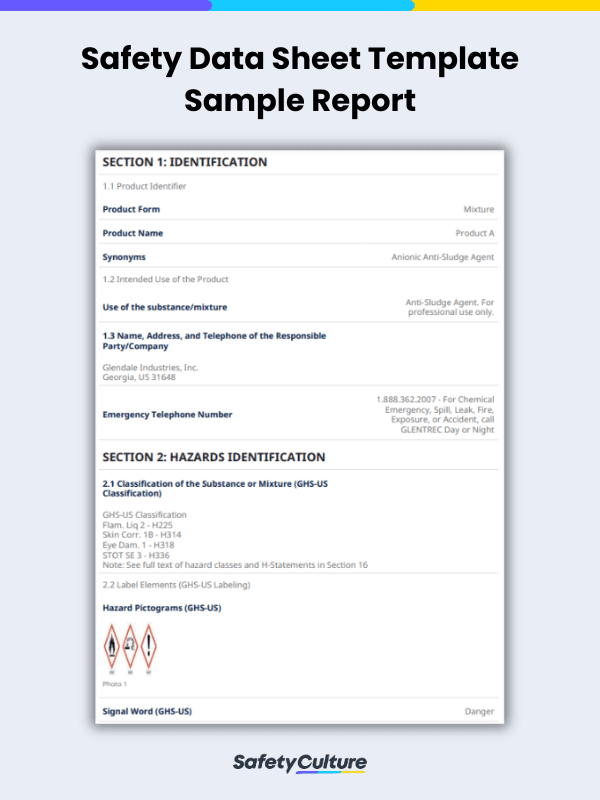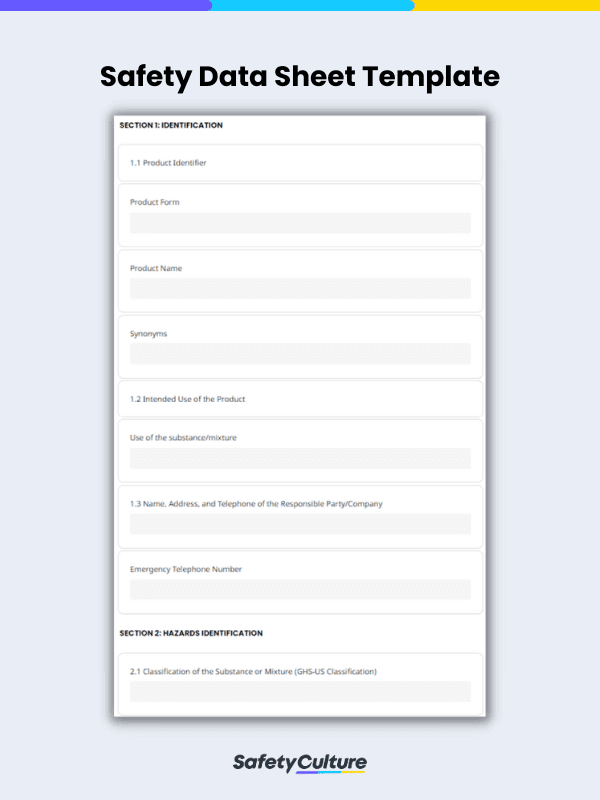What is a Safety Data Sheet
A Safety Data Sheet is a document that provides detailed information regarding the properties, hazards, and safe use of chemicals. It serves as an occupational safety guide for workers when handling hazardous chemicals in a workplace setting. Under the Globally Harmonized System of Classification and Labelling of Chemicals (GHS), the United Nations require safety data sheets to follow a 16-section format with detailed information on chemical properties, hazards, and safety measures.
OSHA’s Hazard Communication Standard and Lab Safety Standard require chemical manufacturers, distributors, and importers to provide safety data sheets on the first delivery of a chemical, and upon request of the client. Facilities that use chemicals are also required by law to have safety data sheets available to workers at all times because they are essential to keeping a safe work environment through awareness of hazards and preventive measures.
7 Vital Items on a Safety Data Sheet
By nature, a safety data sheet is very detailed and comprehensive. So much so, that even professionals can sometimes get lost in the details and have difficulty finding the information they need. Here are some of the most important information on a safety data sheet to help keep the workplace safe:
- Hazard identification (Section 2)
This section informs workers of the possible hazards to look out for when handling a specific chemical, including the degree of flammability, corrosiveness, and toxicity. Short precautionary statements are also included such as the correct protective equipment to wear and first responses in case of unwanted exposure. - Emergency phone number (Section 1)
Chemical manufacturers are required to include an emergency phone number on the first section of the safety data sheet. In cases of chemical emergency, spills, leaks, fires, exposure, or accidents, workers should be able to contact the manufacturer day or night for assistance. - First-aid measures (Section 4)
This section includes instructions on what to do in case of unwanted exposure to a given chemical. It includes first-aid measures for different entry points such as inhalation, skin contact, eye contact, and ingestion. It also includes information on acute and delayed symptoms and effects to look out for when exposed to the chemical. - Handling and Storage (Section 7)
This section talks about the precautions for the safe handling, storage, and transportation of hazardous chemicals. It provides instructions on what to do before, during, and after handling the chemical as well as the specifications for the container, storage condition, and incompatible products that may cause a reaction when mixed with the given chemical. - Exposure controls/personal protection (Section 8)
This section talks about the safety facilities and PPEs that need to be available when handling a given chemical. Examples include having emergency eye-wash fountains and safety showers on-site in case of chemical exposure, usage of explosion-proof equipment, and wearing chemically resistant fabrics. - Stability and reactivity (Section 10)
This provides information on the chemical’s reactivity when mixed with other elements, e.g., if it explodes when mixed with strong oxidizers. It also talks about specific conditions to avoid to prevent unwanted chemical reactions, e.g., avoid direct sunlight, extremely high or low temperatures, and other ignition sources. - Toxicological information (Section 11)
This section provides details regarding the chemical’s toxicity when unwanted exposure occurs. It talks about the degree of skin corrosion, eye damage/irritation, carcinogenicity, and possible consequences of single and repeated exposure to the chemical as well as symptoms and injuries that can be expected based on entry point e.g. inhalation, skin contact, or ingestion.
Is There an Expiry Date for Safety Data Sheets SDS?
The “validity” or expiration date of issued safety data sheets depends on local regulations. There are countries that require updating SDS every 3 or 5 years while in the US, Canada, and Europe, SDS are to be updated as soon as there is new or significant information that will affect the handling of products or protective measures against hazards.
Safety Data Sheet Example
To give you an idea of how a completed Safety Data Sheet looks like, here’s a sample report. View the full PDF report here.

Safety Data Sheet Example PDF | SafetyCulture
Mobile App to Use Safety Data Sheet Templates
Safety data sheets are extensive documents that easily use up numerous pages per chemical. Using the SafetyCulture (formerly iAuditor) mobile app, chemical manufacturers and distributors can create, update, and distribute safety data sheets for clients using customizable templates and share them instantly. Safety officers can also compile, catalog, and distribute safety data sheets to workers through SafetyCulture, and workers can access safety data sheets offline to ensure that proper safety protocols are followed:
- Paperless – Create, update, and distribute paperless safety data sheets all in one mobile app.
- Photo reference – Take photos of best practices, recommended PPEs, and safety facilities for reference.
- Offline access – Access safety data sheets offline through the SafetyCulture mobile app.
- Unlimited storage – Save safety data sheets online and keep them safe in the cloud.



